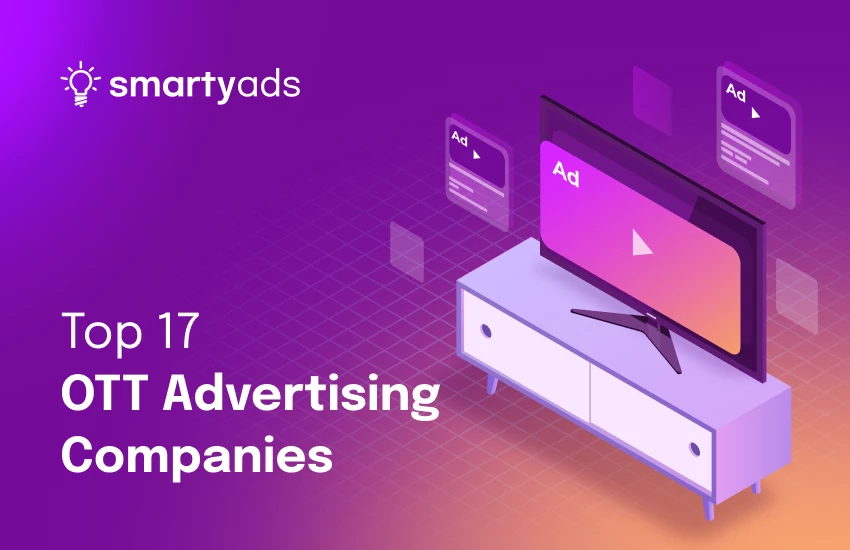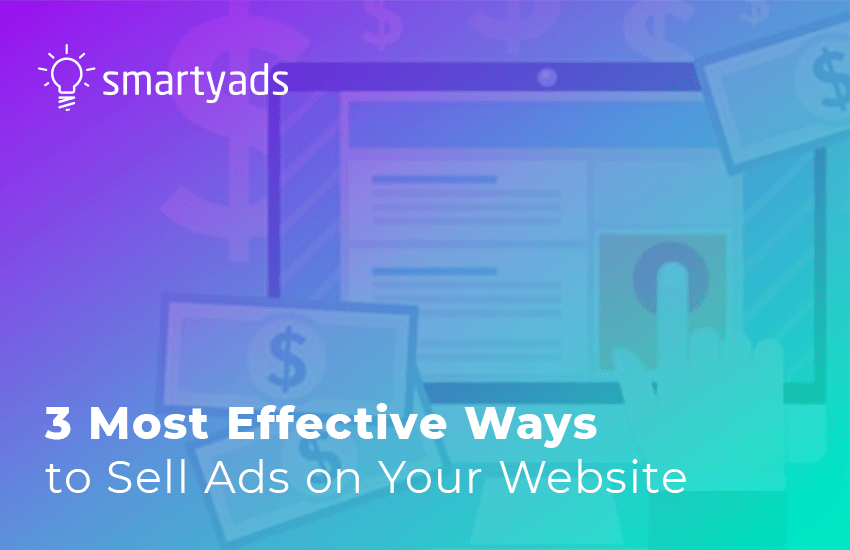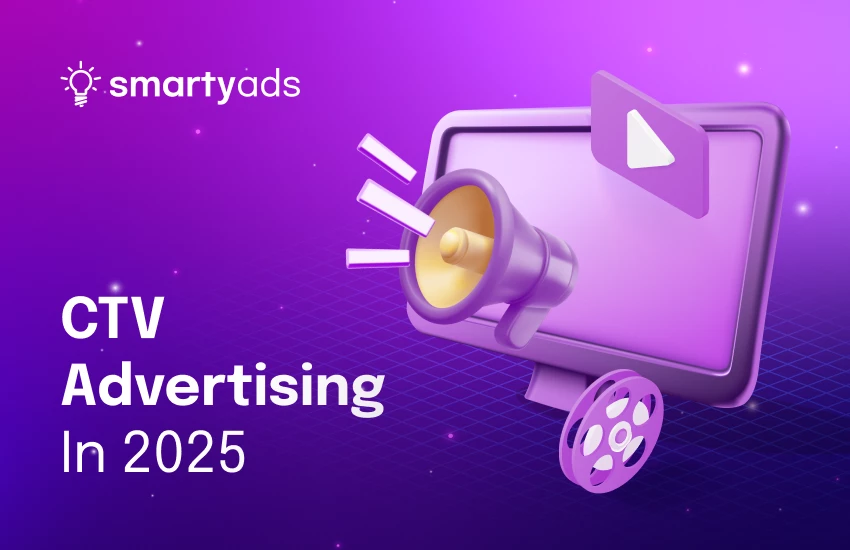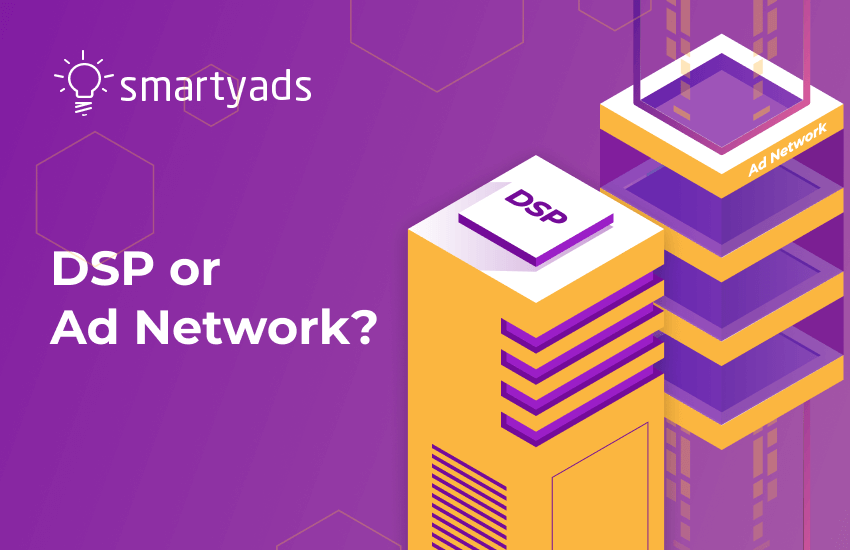The further digital advertising marches into the future, the clearer it becomes: relying solely on social media just doesn’t cut it anymore. As a result, marketing news is now bursting at the seams with shiny new ad formats — digital audio ads, in-game ads — and media buyers are scrambling to jump on these bandwagons, eager to see which one will finally make their brand revenue skyrocket.
Among these rising stars is one format that’s both important and still relatively fresh: OTT, or Over The Top. (And no, not just in the dramatic sense — though the name does have a nice flair.)
Key Takeaways:
- OTT (Over-the-Top) platforms are revolutionizing digital advertising by offering targeted, non-intrusive ad formats that improve user experience and engagement. As more consumers turn to ad-supported services, OTT advertising presents massive opportunities for marketers.
- OTT platforms, including Hulu, YouTube TV, Amazon Prime, and Netflix, provide vast audiences for ad placements. These platforms use programmatic advertising to deliver personalized video, audio, and interactive ads based on user behavior, preferences, and demographics.
- Programmatic advertising offers greater efficiency, real-time performance tracking, and optimization, making it an ideal choice for advertisers. Direct purchases are also possible, though they come at a higher cost.
- SmartyAds DSP provides a comprehensive solution for advertisers, offering access to premium OTT platforms and advanced targeting tools to maximize campaign effectiveness and reach. It ensures that ads are shown to the right audience at the right time, boosting performance and revenue.

What is OTT?
OTT (Over The Top) is TV or video streamed directly over the Internet. Users do not need to pay for habitual cable or satellite TV services to access OTT content.
This content can be watched on various devices: tablets, phones, laptops, PCs, TVs, etc. OTT videos are streamed or available on demand.
Examples of OTT services:
Hulu, Netflix, and Amazon Prime. Many media outlets, networks, and media-buying companies, such as Disney+ and NBC's Peacock, are also launching their own OTT services.
However, don't mistake OTT for another popular trend in TV development — CTV (Connected TV). Connected TV must have a device to stream the video or show. Let's explore it a little more closely.
Read more about Connected TV advertising and marketing here.
Linear Television
Linear TV is a classic television with a schedule of programs broadcasted on specific channels. To watch linear TV, you need to use an antenna or pay for a cable/satellite TV connection.
About 200 million people in the U.S. use ad-supported streaming services.
America is the second largest AVOD market after India, where more than half a billion users watch video content for free thanks to CTV and OTT advertising.
The differences between OTT, CTV, and Linear TV
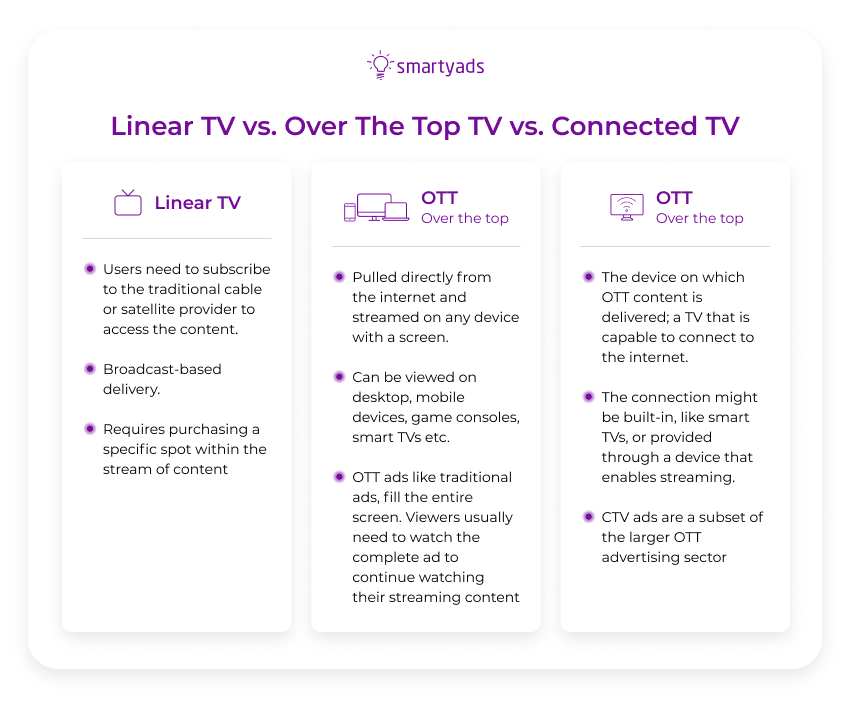
And some more numbers
8 out of 10 AVOD service users also pay for SVOD platforms, and 7 out of 10 use pay TV.
Wait, wait, what is AVOD, SVOD, etc.?
Would we scare you too much if we told you there are also TVOD and MVPD? We hope not, because we promise we'll explain it now!
Types of OTT platforms
Transactional video on demand (TVOD)
It's working on a Pay-per-view system. Payment is made for specific content, such as a movie. Some examples are iTunes, Google Play, Vudu, and Vimeo.
Advertising Video On Demand (AVOD)
You can watch videos for free, but you'll also have to watch advertising messages. Resources with free streaming content use built-in advertising integrations.
It is a huge playground for advertising and marketing activities, where digital media buying can be set up automatically (thanks to programmatic technology).
With this, businesses can personalize ads and commercials for different audience segments.
YouTube, Twitch, TubiTV, Hulu, Pluto, and Crackle use this principle.
Subscription Video On Demand (SVOD)
The user can avoid watching advertising messages if they pay for this option. Privileged access is given to those who don't want to watch ads.
This is how Netflix, Disney Plus, Hulu Plus, Amazon Prime Video streaming services work.

Multichannel program distributors (MVPDs)
They use the payment for streaming and broadcast content. They include streaming services such as AT&T Now, Sling, and YouTube TV.
Video advertising is very important for digital advertising in general and many brands in particular.
Connected TV and OTT advertising play a huge role in developing video advertising, so it will be useful for any marketer to learn about the services on which such advertising can be placed.
What is OTT advertising?
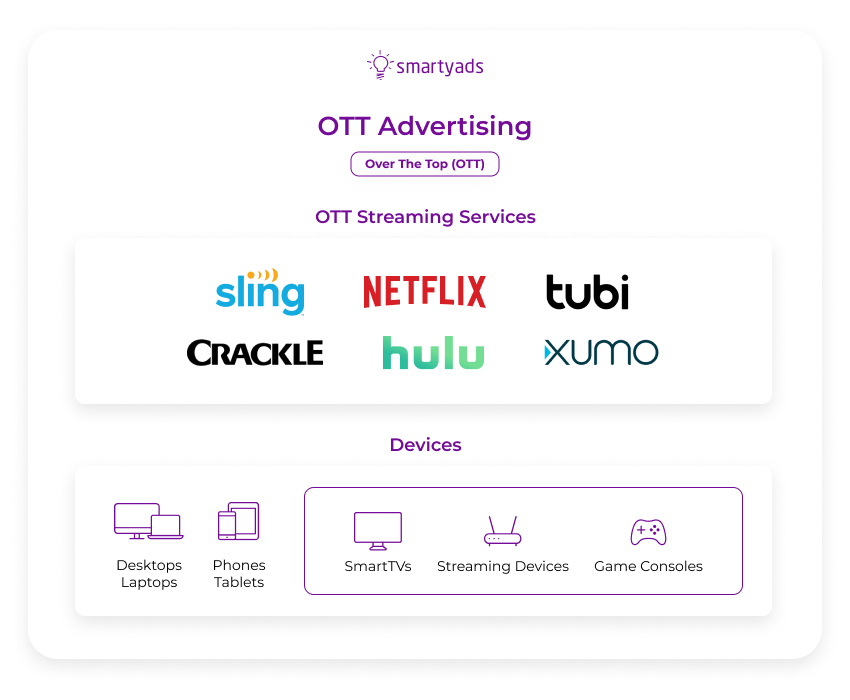
OTT advertising can be enabled by programmatic advertising delivered to viewers via online platforms or streaming devices.
Usually, these are video ads, but OTT allows other types of ads to be displayed, including audio and interactive ads.
There are several types of OTT advertising purchases:
Programmatic advertising
Programmatic advertising is represented by automated media buying initiated by the video hosting through specialized platforms. The method has obvious advantages in terms of optimization and targeting.
Targeting in programmatic personalizes impressions for different users, even though they may be watching the same show.
In other words, the platform primarily considers the user's interests and uses them to select TV advertising that is most suitable for display.
This way, cord-cutters won't be annoyed by watching the ads but will move further down the marketing funnel.
Additionally, this data-driven digital technology allows advertisers to run ads according to budget strategy. Companies and businesses can adjust media selection rules and distribution of marketing budgets.
The OTT business commercials can also be optimized for certain media (depending on the advertising platform's functionality).
Plus, programmatic OTT advertising platforms are also good for companies because this digital technology has real-time reporting and analysis.
Direct purchase on the platform
This method of placing OTT ads involves interaction with the device provider.
Direct purchase from the publisher
Advertisers who want to know for sure where their ads will be placed normally choose direct programmatic deals. Unlike in RTB auctions, in direct deals publisher sells ad inventory directly to the advertiser.
This approach allows you to choose the place and time of display of advertising materials and the option of targeting your audience. Everything would be fine, but such integrations are incredibly expensive.
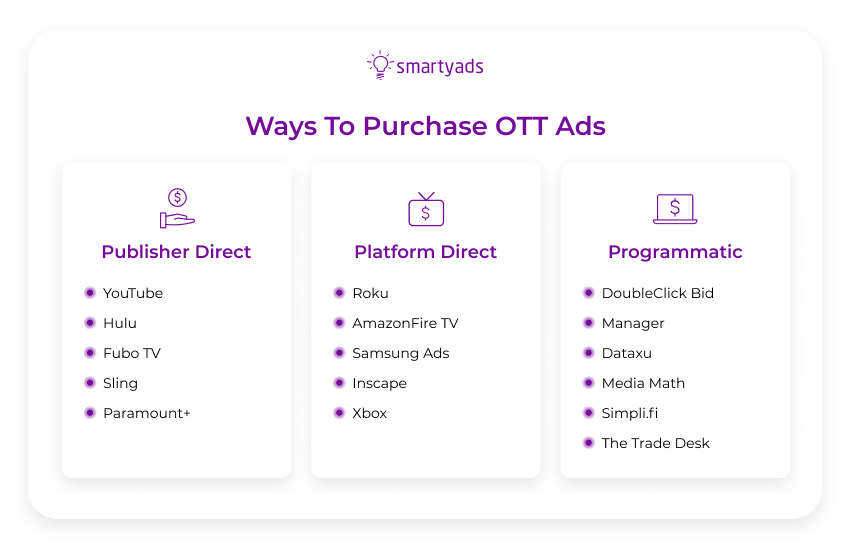
Streaming services do not need to worry about planning the broadcasting grid or the show's geography.
Unlike television, viewers can access long-form content anytime, as long as they have access to a platform in a particular region.
It is predicted that by 2027 the revenue per user from OTT advertising will exceed the revenue from streaming subscriptions.
The grow of Over The Top advertising revenue per user
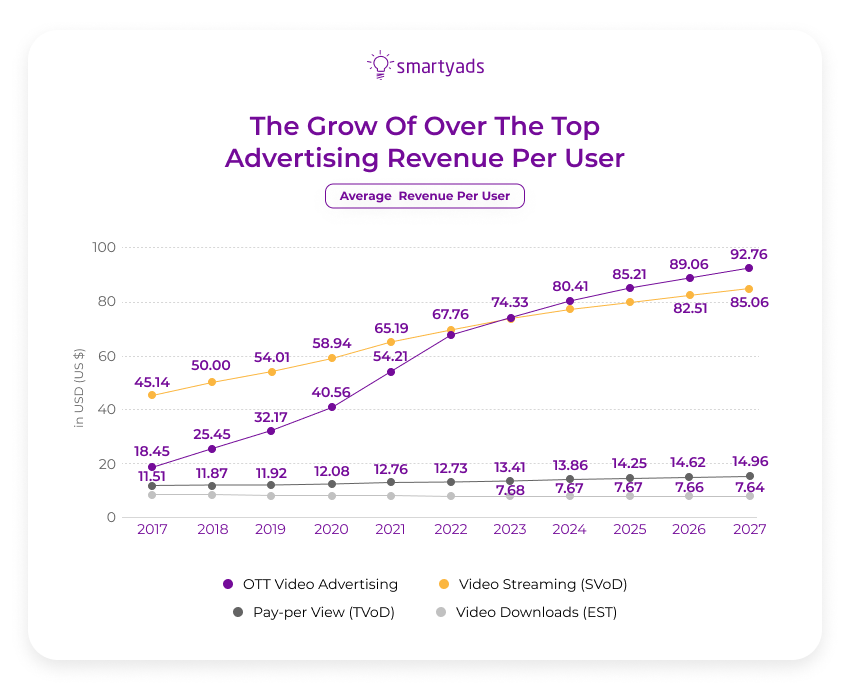
Advertising agencies
Sometimes an advertising agency or business helps a brand create its own OTT advertising service.
For example, the independent advertising agency WorkInProgress helped Dominos gain additional advertising independence in OTT advertising.
And Allstate created a whole infomercial because, at some point, they changed their advertising agency and, accordingly, their TV advertising strategy, which is the basis of their marketing.
A media buying, marketing, or advertising agency can have a huge influence on the development of TV advertising, as well as on the development of TV advertising strategies for certain brands.

Benefits of Connected TV and OTT advertising
Targeting diversity
Connected TV and OTT advertising platforms can use all sorts of targeting, from geolocation to search histories, watched movies, and installed games. Detailed targeting can help the business to address only the right audience on the proper media sources.
A high percentage of ad visibility
With targeted digital advertising, the user is far from wanting to skip it because the more the ad catches on, the greater its usefulness and, therefore, the percentage of visibility.
Opportunities for advanced analytics
Due to the detailed ad customization and more information, the analytics of Connected TV ads and OTT ads are also more advanced.
Advertisers have data about users and current ad campaigns: the percentage of viewing the ad, interaction with it, the number of skips, and users' actions after viewing the ad.
This, in turn, helps to evaluate the effectiveness of ads and optimize them objectively.
Now, let's review popular OTT ad companies.
17 Best OTT Advertising Platforms
Ah, the ever-expanding universe of best OTT platforms! Once upon a time, we had just a handful of choices, but now the options are as abundant as sequels in a superhero franchise. Everyone knows about Netflix and Roku, but if you're looking for alternative (sometimes cheaper) options for TV advertising.
Knowing about other OTT advertising services where you can place your video ads or launch an OTT advertising campaign is helpful.
Peacock TV
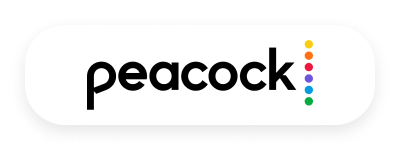
NBC Universal’s shiny streaming service offers a mix of original movies, beloved NBC classics, live events, news, and sports. It’s a smorgasbord of content. It's a solid option for placing OTT advertising. Also, 77.7% Of Peacock Subscribers Use Ad-Supported Plan As Of 2025.
Pros: Large, diverse audience; great for brand exposure across multiple genres.
Cons: Limited international reach, which means less global visibility.
The number of active audiences: 36 million in the U.S.
AT&T TV

AT&T TV offers multichannel streaming using Android TV set-top boxes, rented to subscribers if needed. It’s traditional TV meeting the digital age.
Pros: Strong targeting capabilities; the audience is used to seeing ads.
Cons: Requires specific hardware, which limits ad reach.
YouTube TV
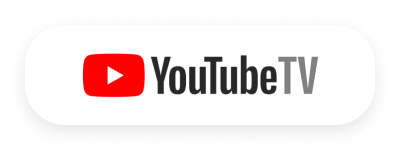
YouTube TV is a The platform everyone knows, offering live streaming and cloud DVR from over 85 networks.
Pros: Highly flexible ad formats and massive reach.
Cons: Fierce competition and potential ad fatigue among users.
The number of active user base per month: 2.5 billion.
ZEE5

ZEE5 is an online OTT platform offering viewers a fully integrated entertainment experience with live and on-demand broadcasts. Its large audience allows OTT advertising to reach any target group.
Pros: Huge audience and multilingual content allows precise regional targeting.
Cons: Limited awareness and reach outside South Asia.
The number of active users per month: 92 million.
Acorn TV

Acorn TV is the home of British mystery, drama, and comedy — basically a cozy tea-time for your ad campaigns.
Pros: Niche audience with high engagement.
Cons: Small user base limits reach.
Apple TV+

Apple’s sleek service with award-winning originals and a premium audience.
Apple TV+ provides a subscription-based streaming TV service, including Apple Originals. Available long-form content includes award-winning series, gripping dramas, innovative documentaries, kids' shows, comedies, and more. The service can be run on many Apple devices, making it a good opportunity to launch a multichannel OTT ads campaign.
Pros: Affluent, tech-savvy audience with high purchasing power.
Cons: Still a smaller content library compared to other major players.
The user pool: around 44 million viewers.
BritBox
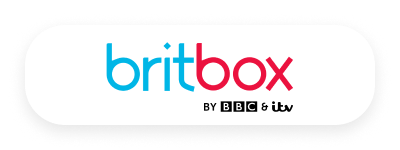
A haven for fans of British TV, featuring current and classic series.
BritBox is an online digital video subscription service focusing on British series and films, provided by the main British public broadcasters (BBC, ITV, Channel 4, and Channel 5), as well as original shows. A goldmine for advertisers targeting the British market.
Pros: Perfect for targeting a UK-based, loyal audience.
Cons: Limited reach outside the UK.
The user pool: 3 million.
FuboTV

FuboTV is the leading platform for live sports broadcasts, highly appreciated by sports fans and world cup enthusiasts.
Pros: Highly engaged sports fans make for targeted and passionate audiences.
Cons: Focused primarily on sports, limiting ad variety.
The user pool: 2 million.
Amazon Prime Video
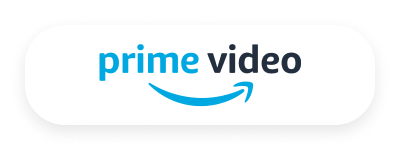
Amazon Prime Video is an OTT streaming video platform that allows Amazon Prime members to watch movies and shows. It's one of the world's most popular video streaming services, making it ideal for your OTT ads.
Pros: Massive audience and advanced targeting options.
Cons: Cluttered ad space; standing out requires creativity.
The user pool: 200 million.
HBO Max

Everyone knows about HBO Max — it's a subscription video streaming service.
The service offers a range of original shows, archived content from the company, and additional content licensed by third-party distributors.
The service is relatively young (founded in 2020), but it is still rapidly gaining popularity, and the number of viewers is only growing.
Therefore, it is a great platform for OTT advertising.
Pros: Enormous reach and diverse demographics.
Cons: Just starting to roll out ads, making the landscape unpredictable.
The user pool: 103 million.
Netflix

Only a hermit living in the deep woods without the Internet probably doesn't know about Netflix. But we'll tell you about it anyway.
Netflix is the world's leading streaming entertainment service, with 207 million paid subscribers in more than 190 countries.
The service lets you watch series, documentaries, and movies in a wide variety of genres and languages. It’s an excellent option for placing OTT advertising.
Pros: Enormous reach and diverse demographics.
Cons: Just starting to roll out ads, making the landscape unpredictable.
The user pool: 283 million.
Hulu

Hulu is a leading premium streaming service that offers live and pre-recorded shows and films, with and without TV advertising, in and out of the home.
More and more people are abandoning paid subscriptions in favor of free, but with ads, so Hulu would also be a great option for OTT advertising as well as for CTV advertising.
Pros: Established ad infrastructure and engaged audience.
Cons: Ad-supported tier users expect frequent breaks — be memorable or risk being skipped.
The active user base: 50.2 million.
Paramount+

Paramount+ is an American subscription video-on-demand streaming service owned and operated by ViacomCBS Streaming.
The service offers films, dramas, news, cartoons, and comedies. Perfect for displaying a wide variety of OTT advertising.
Pros: Wide variety of content appeals to multiple demographics.
Cons: Still growing its audience compared to bigger players.
The monthly user base: 77,5 million.
Rakuten TV
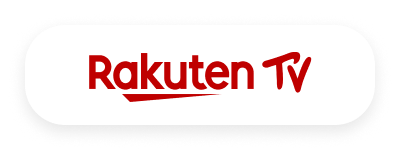
Rakuten TV is a video-on-demand (VOD) streaming TV service that offers films and shows that can be streamed to multiple devices.
The service is very close to Netflix, so OTT advertising will also be very good.
Rakuten Advertising can help any business to promote services or goods effectively with its media platforms: Rakuten Viki, Rakuten Viber, and more.
Rakuten Advertising an exclusive partner of SmartyAds. Ask your manager to find out more about its media opportunities.
Pros: European market access and quality content.
Cons: Smaller user base compared to global giants.
Sling TV

Sling TV is a streaming TV service offering virtual multichannel video shows, videos, and Over The Top services that can be streamed through smart TVs, digital media players, and apps.
A great option for placing OTT advertising.
Pros: Affordable ad slots and a highly customizable audience reach.
Cons: Smaller user base compared to larger competitors.
The user base: 2.09 million.
Showtime

Showtime is a premium television network that provides distributors with traditional and premium multichannel video programming through Apple TV and Amazon Video Channels.
They offer content from the VOD library and live streaming of Showtime's linear TV service.
It's one of the oldest services for providing video content to users, rightfully earning their trust. Therefore, it's one of the best platforms for Over The Top advertising.
Pros: High-quality content attracts a dedicated and engaged.
Cons: Premium pricing limits the ad-supported audience.
Tubi

Tubi is the largest free live TV and movie app that gives viewers access to the largest library of premium TV shows and films through streaming on a connected TV device.
It will be good for both Over The Top and Connected TV advertising.
Pros: Completely ad-supported, providing wide and cost-effective reach.
Cons: Ad-heavy experience may lead to viewer fatigue.
The number of active users per month: 97 million.
Bottom Line
When it comes to media buying and digital ad strategy, Over The Top (OTT) is like the cool kid at the marketing party — everyone wants a piece of it and for good reason. It’s a powerhouse for business growth, offering the kind of audience reach and engagement that traditional channels can only dream of.
With a dazzling array of OTT advertising platforms out there, advertisers now have their pick of the litter. Whether you’re aiming for niche audiences or mass appeal, there’s a perfect channel waiting to deliver your message in style.
But here’s the kicker — not all OTT ad platforms are created equal. If brand safety and quality are non-negotiable for you (and they should be), a trusted marketing automation platform like SmartyAds has your back.
Want your ads to make a real impact? With SmartyAds DSP, you can craft killer OTT media opportunities that not only reach the right audience but do so with precision and flair. Let’s turn those ad dollars into gold.
FAQ
OTT viewers are generally more engaged because they choose the content they watch. Ads can be interactive or personalized, resulting in higher attention and conversion rates than standard linear TV commercials.
Beyond impressions and clicks, OTT platforms offer metrics like completed views, engagement rates, and cross-device conversions. These help advertisers understand both attention and downstream impact on purchases.
Programmatic platforms like SmartyAds DSP allow brands to place OTT ads across multiple networks and devices, including AVOD, SVOD, and Connected TV platforms. This centralized approach simplifies targeting, tracking, and campaign optimization.
OTT can complement social media, search, and display campaigns by reaching audiences in “lean-back” environments, providing top-of-funnel brand awareness while reinforcing other channels for conversions.

